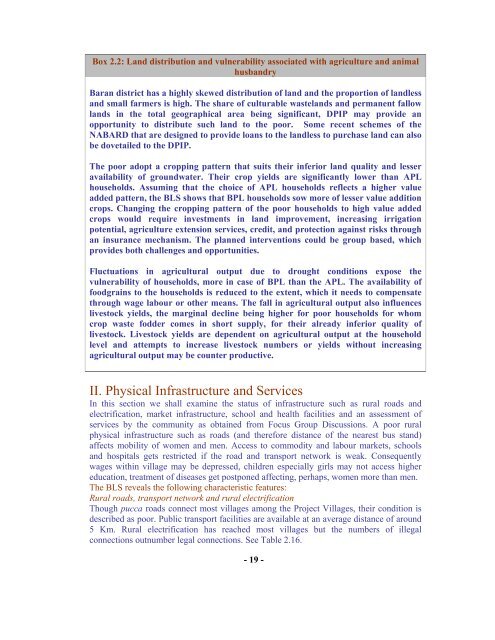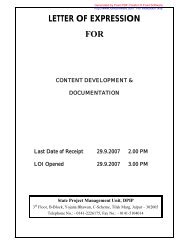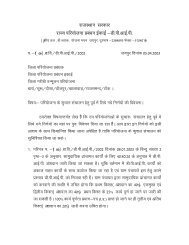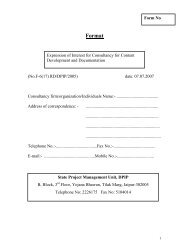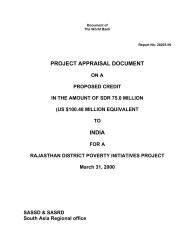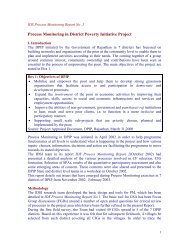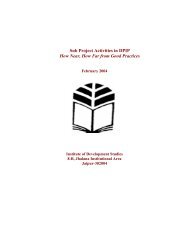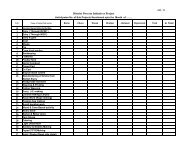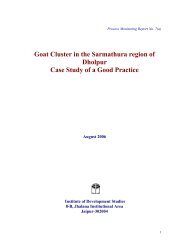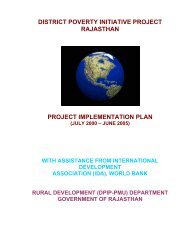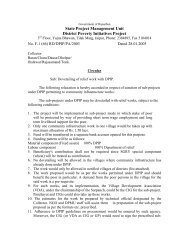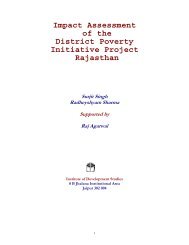Download PDF - Rajasthan Rural Livelihoods Project
Download PDF - Rajasthan Rural Livelihoods Project
Download PDF - Rajasthan Rural Livelihoods Project
You also want an ePaper? Increase the reach of your titles
YUMPU automatically turns print PDFs into web optimized ePapers that Google loves.
Box 2.2: Land distribution and vulnerability associated with agriculture and animalhusbandryBaran district has a highly skewed distribution of land and the proportion of landlessand small farmers is high. The share of culturable wastelands and permanent fallowlands in the total geographical area being significant, DPIP may provide anopportunity to distribute such land to the poor. Some recent schemes of theNABARD that are designed to provide loans to the landless to purchase land can alsobe dovetailed to the DPIP.The poor adopt a cropping pattern that suits their inferior land quality and lesseravailability of groundwater. Their crop yields are significantly lower than APLhouseholds. Assuming that the choice of APL households reflects a higher valueadded pattern, the BLS shows that BPL households sow more of lesser value additioncrops. Changing the cropping pattern of the poor households to high value addedcrops would require investments in land improvement, increasing irrigationpotential, agriculture extension services, credit, and protection against risks throughan insurance mechanism. The planned interventions could be group based, whichprovides both challenges and opportunities.Fluctuations in agricultural output due to drought conditions expose thevulnerability of households, more in case of BPL than the APL. The availability offoodgrains to the households is reduced to the extent, which it needs to compensatethrough wage labour or other means. The fall in agricultural output also influenceslivestock yields, the marginal decline being higher for poor households for whomcrop waste fodder comes in short supply, for their already inferior quality oflivestock. Livestock yields are dependent on agricultural output at the householdlevel and attempts to increase livestock numbers or yields without increasingagricultural output may be counter productive.II. Physical Infrastructure and ServicesIn this section we shall examine the status of infrastructure such as rural roads andelectrification, market infrastructure, school and health facilities and an assessment ofservices by the community as obtained from Focus Group Discussions. A poor ruralphysical infrastructure such as roads (and therefore distance of the nearest bus stand)affects mobility of women and men. Access to commodity and labour markets, schoolsand hospitals gets restricted if the road and transport network is weak. Consequentlywages within village may be depressed, children especially girls may not access highereducation, treatment of diseases get postponed affecting, perhaps, women more than men.The BLS reveals the following characteristic features:<strong>Rural</strong> roads, transport network and rural electrificationThough pucca roads connect most villages among the <strong>Project</strong> Villages, their condition isdescribed as poor. Public transport facilities are available at an average distance of around5 Km. <strong>Rural</strong> electrification has reached most villages but the numbers of illegalconnections outnumber legal connections. See Table 2.16.- 19 -


